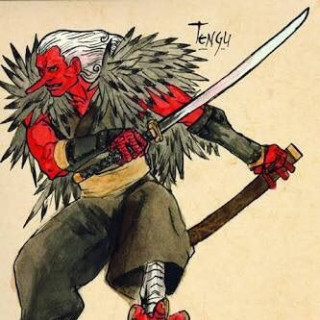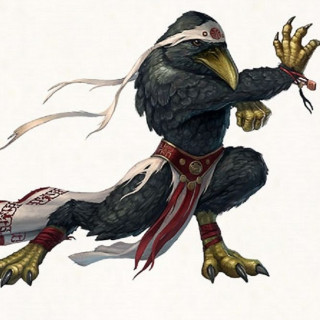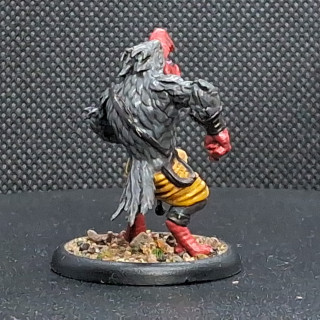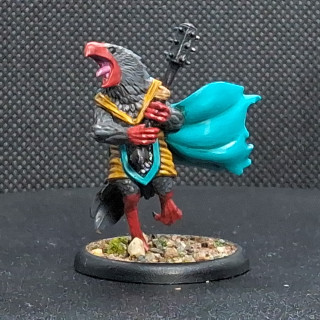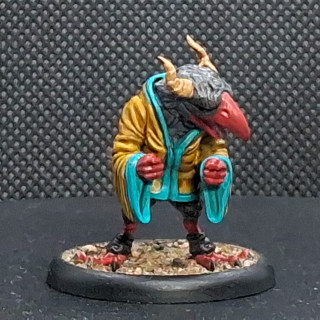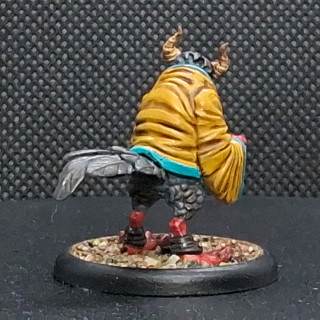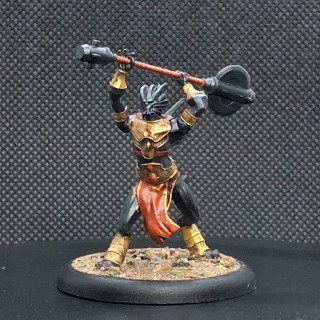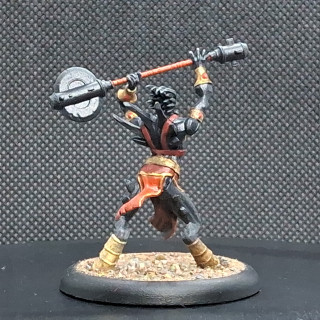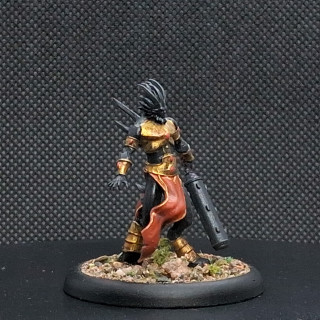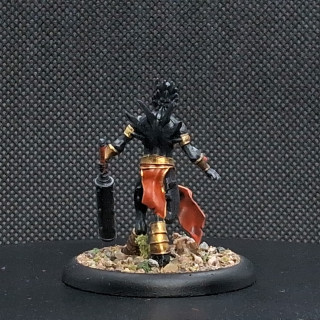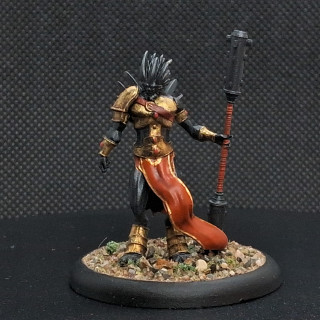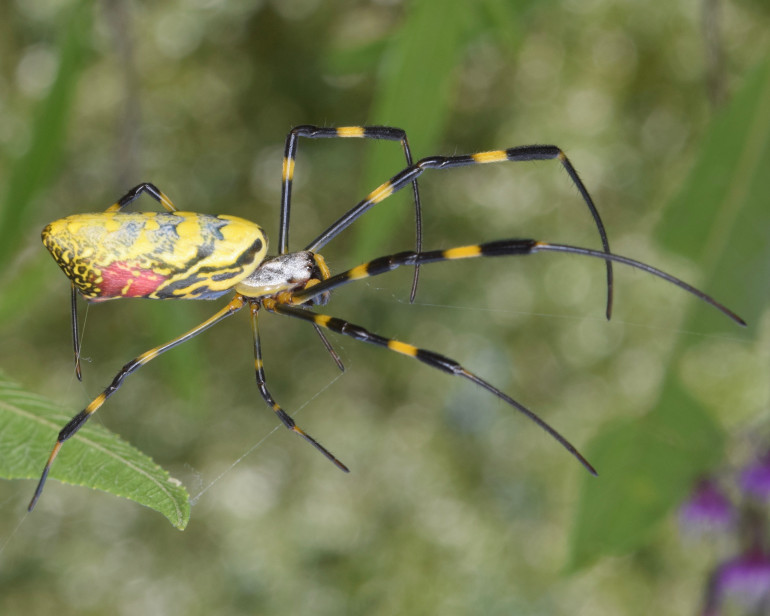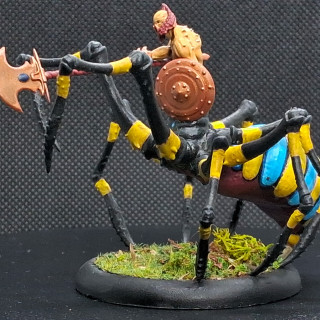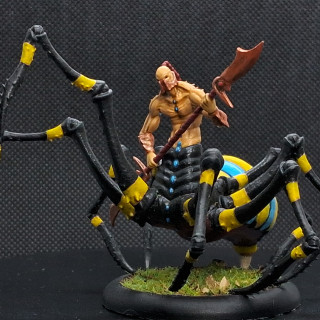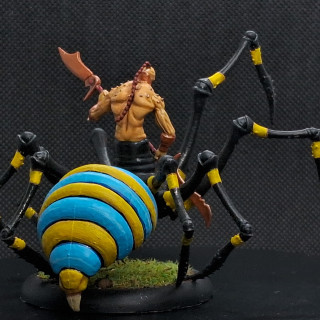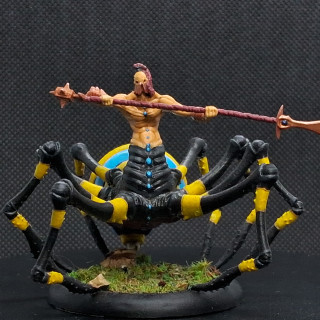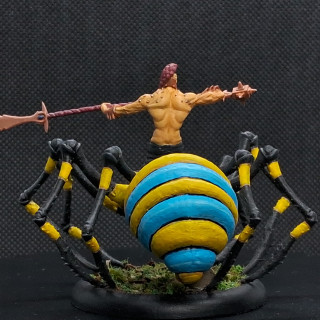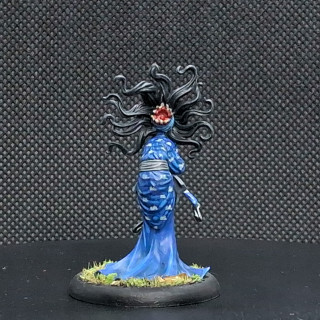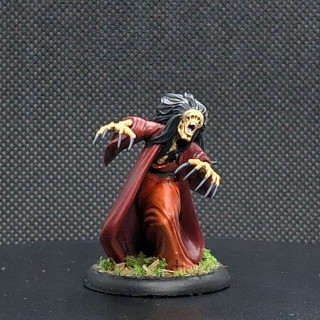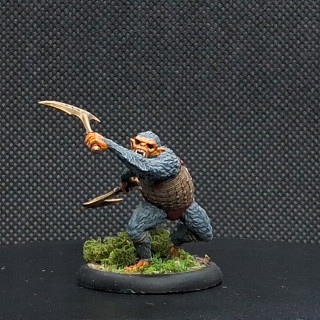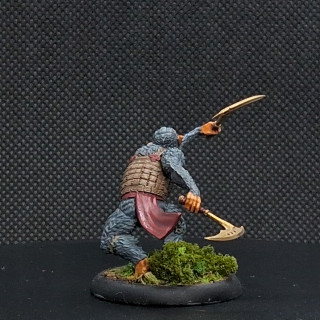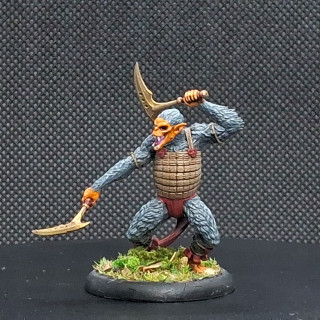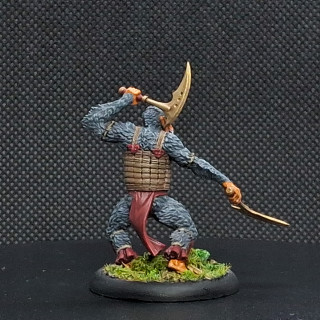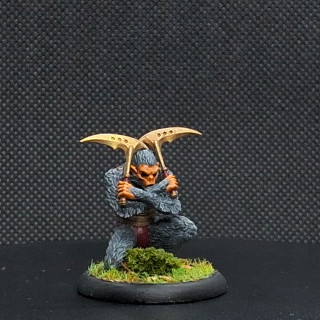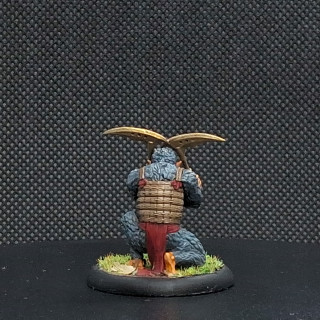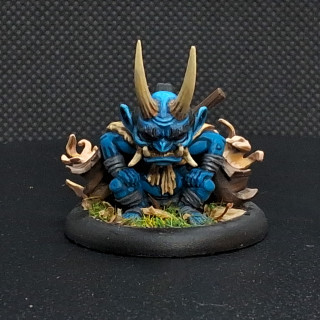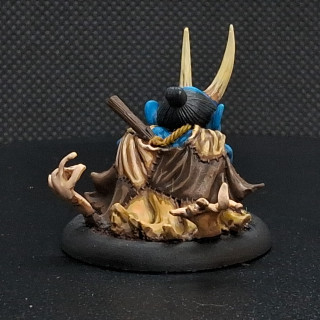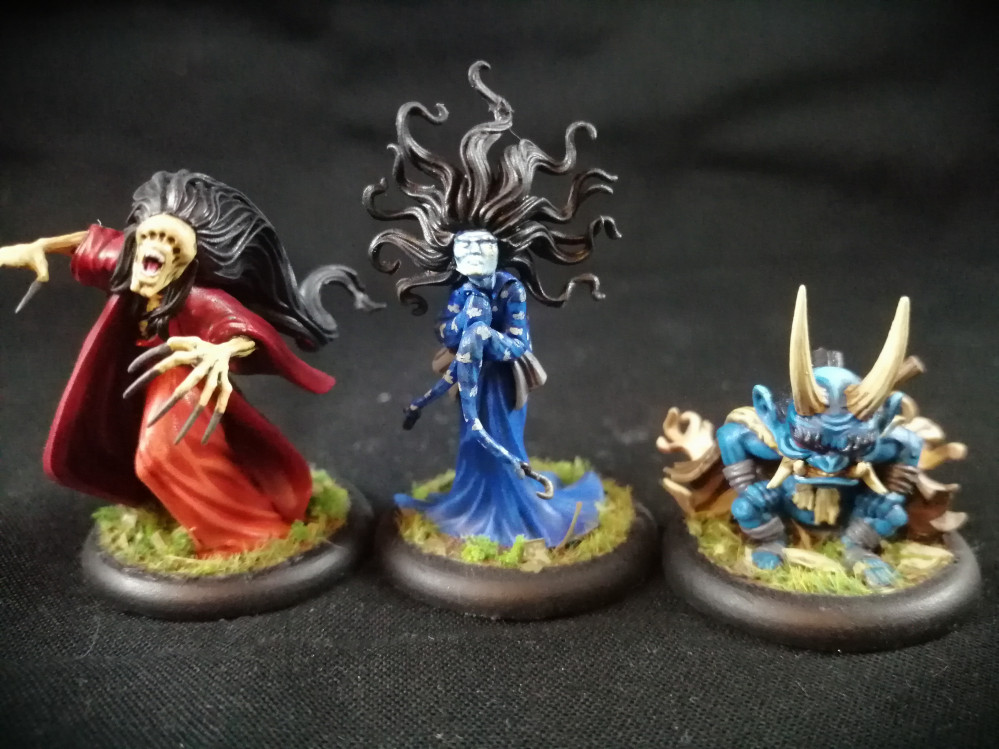
Malifaux – Asami Tanaka
Recommendations: 21
About the Project
A project describing my collecting and painting models for the game Malifaux, specifically using the master model, Asami Tanaka, of the Ten Thunders clan.
Related Game: Malifaux
Related Company: Wyrd Miniatures
Related Genre: Pulp
This Project is Active
Tengu
Time to expand my summoning options again for Asami Tanaka. This time we are adding some cheap minions in the form of the tengu, bird like demons with some nice movement options and a real handy heal effect built into their rules.
Assembly went fine. Fiddly as all-hell, but that’s Malifaux.
I brush painted on some Vallejo Ghost Grey primer as I didn’t want to faff about with an airbrush for 3 models.
Cool though they are, I didn’t want to copy the Wyrd studio paint job as I don’t think they look ‘demony’ enough. I got my google-foo going and started trawling for information about the mythology and imagery behind the tengu in Japanese mythology.
It seems Tengu is actually a named demon individual who commonly wears a mask and has a long nose. He has various minor demonic servants (koppa tengu) that seem to be more like the imagery Wyrd used to create the models.
Classically a lot of oni demons in Japanese mythology have red skin so I decided to go with this vibe by using Vallejo Model Color (VMC) Vermillion for beaks, hands and legs.
Although the three models in the box are different sculpts and poses, I wanted to use a common colour palette across their robes. I saw a great image with a tengu in a yellow tunic so decided to use that as another of my common colours, settling on VMC Gold Brown, a lovely warm yellow.
Taking a look at a colour wheel there was an interesting split complement triad using these two colours and a teal blue (VMC Blue Green), so I decided to use that as my second colour on cloaks and fabric details.
As the models are so different I’ll list colours used with images of the relevant model below. As usual all paints are Vallejo Model Color unless otherwise stated.
Feathers – London grey
Bandolier – German Camo Black Brown
Skulls – Tan Yellow
Beak, hands and feet – Vermillion
Skirt – Gold Brown
Weights? On skirt – Black then Oily Steel
Talons on feet, eyes – Black
Inside beak, tongue – Pink
Feathers – London grey
Mace handle – German Camo Black Brown
Mace handle wrap – Tan Yellow
Beak, hands and feet – Vermillion
Tunic – Gold Brown
Cloak, stomach plate border – Blue Green
Mace head, scales on stomach plate – Black then Oily Steel
Talons on feet, eyes – Black
Inside beak, tongue – Pink
Feathers – London grey
Ankle wraps – German Camo Black Brown
Horns – Tan Yellow
Beak, hands and feet – Vermillion
Jacket – Gold Brown
Jacket border – Blue Green
Talons on feet, eyes – Black
Inside beak, tongue – Pink
Regular viewers of my projects know that base coats and a wash is normally where I stop as my models are gaming pieces first and foremost. However after a heavy wash in Citadel Colour Agrax Earthshade, the fabrics looked awful with pooling and tidemarks all over, particularly on the teal coloured cloak. So I went back in with the Gold and Blue Green colours and repainted everything in a highlight pass covering 60-80% of the original colour and leaving shade where needed.
Basing was Geek Gaming Scenics Base Ready Mediterranean Soil over a base coat of US Field Drab so we don’t get spots of light grey primer showing through.
Obsidian Oni
Having no unpainted Malifaux models (don’t worry I have hundreds of models for other games still untouched), I gave myself permission to further expand my collection with models I can play with Asami.
In Malifaux models in your warband must either share a keyword with your master (in Asami’s case ‘Oni’) or have the ‘Versatile’ keyword and be in your faction (in Asami’s case Ten Thunders).
What tends to happen is that many of the versatile models are great multi-purpose options for a host of Ten Thunders warbands, so meta lists tend to focus around these models as additions after your master and best in-keyword picks.
The main drawback in Asami warbands is that she can summon extra models but ONLY models with the Oni keyword. This means that if I were to lose a key versatile model I cannot summon it back into existence. Another thing that occurred to me is that if I did have a collection of Oni models, I can summon exactly the model I need to fit a particular circumstance in pretty much any game. More Oni is more options I can legitimately use in any game. With this in mind I decided to just collect models with the Oni keyword and skip the versatile options.
After a spending binge at UKGE 2023, I bought all of the Malifaux boxes with Oni model options currently available. With consideration my next project was the Obsidian Oni minions. I chose these models as they work particularly well if summoned vs bought in the original warband by spending soulstones. The main drawback of summoning versus point buy in terms of a models function is that summoned models enter the table with a built in clock that will eventually ‘kill’ them after a number of activations. While there are ways to extend the clock on a summoned model it can be fiddly and costly in activations for support models, so models that give value back when they die seem perfect summoning fodder. Enter the Obsidian Oni. These guys are pretty punchy and have a ‘demise’ ability (in Malifaux, an ability that triggers when you die) that basically causes them to explode and do more damage. So I can summon them, charge at the enemy, pumping my attacks with abandon and then explode in their face at the end of my activation, setting everything near me on fire. Does that not sound awesome?
Painting
Wyrd have these guys depicted as a lilac colour in the artwork which I think is weird as Osidian is black. Very black. And glossy. So…
First step was to prime with Vallejo Black Primer then the whole model was sprayed with Turbo Dork Black Ice which is a metallic black paint. Now that screams obsidian demon to me.
The rest of the colours are broken down below. As usual all paints are Vallejo Model Colour (VMC) unless otherwise specified.
Weapon handles and fabric tabbard – Clear Orange
Armour – Gold
Straps – Cavalry Brown
Easy. All the non black colours were selectively shaded with Citadel Colour Agrax Earthshade and as a final touch all the gemstones were picked out in VMC Vermillion.
I forgot how exactly I’d based my old models but I’m guessing I used a custom mix of flocks I have since exhausted (damn you Burrows and Badgers), so for speed I went with my old faithful Geek Gaming Scenics Base Ready Mediterranean Soil over VMC US Field Drab.
Jorogumo
My first expansion product was by recommendation, and that was the Jorogumo box. These models are absolute killers and are very useful for just making stuff dead when you need it, and they were recommended as a good way to shore up Asami’s weaknesses against some opponents.
In terms of painting I wanted to do something way more exciting than Wyrd had done (essentially shades of grey). A bit of googling and I found Trichonephila Clavata. Originally native to Japan but now common in some parts of the USA, this species is commonly called the Joro spider. I even found one reference that stated this spider was the inspiration for the Jorogumo myth. As you can see from the image below the colouration of the female spider is amazing and looks incredibly alien.
This was an easy decision and I am very happy with my paint jobs on these models (which are massive by the way). I feel they capture perfectly the bright almost cartoony style which pervades a lot of ancient Japanese folk art.
This was easily enough models to play a full 50 soulstone game of Malifaux and I had a good many games with these before buying anything else, mainly because
a) the Jorogumo are expensive models ‘in-game’ and
b) Asami requires a significant resource pool of soulstones to be kept in reserve (i.e. not spent on models) to fuel her in game summoning ability. Yes, you get to make more toys. Mwahahaha.
Just to be clear, this is not hugely exceptional. A core box and a single expansion is sufficient models to play many of the masters in Malifaux. This means that, due to free downloadable rules, for £80 or so you can be up and running playing Malifaux most of the time.
The only other game asset you will need is tokens and markers. Most markers used on the tabletop have a fixed size and many companies do after-market options in card, acrylic and MDF, although I bought 30mm bases and used stickers to create my own very cheaply.
Asami Core Box
To open this project I just have a few thoughts and photos. I painted these models years ago and did not keep painting records at that time. Sorry.
So, why Asami? Largely considered one of the weaker masters in the Malifaux game ‘meta’ in both the current 3rd edition and the previous 2nd edition, I chose Asami for the aesthetic alone. As a complete fan of Japanese history and mythology I could not turn my back on her model collection in the game. Competitiveness is never a major checkpoint for me and, in fact, I relish the challenge of playing underdog lists in wargames generally. Also, having played a similarly uncompetitive master before (Wong of the Bayou faction), I am confident that Malifaux game system still gives me opportunities for enjoyment when on the back foot. I don’t play with a group of guys that build prickly tournament lists anyway so I’m sure it’ll be fine, this isn’t a Games Workshop game after all. XD
When painting these models I drew heavy inspiration from the Wyrd artwork and studio paint jobs. I did change a couple of things, such as the painting the Yokai with grey fur not blue, but basically it was close to the Wyrd artist’s style.
Asami tanaka
One aspect of Asami’s paint job I am proud of the is the cloud motif on her kimono. All freehand painted, and the final look is way better than I was expecting.









































